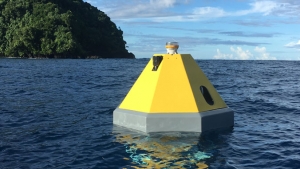
NOAA, the Pacific Islands Ocean Observing System (PacIOOS) at the University of Hawaiʻi at Mānoa and partners have launched a new buoy in American Samoa’s Fagatele Bay national marine sanctuary. The buoy will measure carbon dioxide and other important seawater characteristics within the bay’s vibrant tropical coral reef ecosystem.
“This new monitoring effort in a remote area of the Pacific Ocean will not only advance our understanding of changing ocean chemistry but will also help us communicate these changes to diverse stakeholders in the Pacific Islands and across the United States,” said Derek Manzello, coral ecologist with NOAA’s Atlantic Oceanographic and Meteorological Laboratory.
Fagatele Bay is home to more than 160 species of coral, as well as giant clams, fish, dolphins and the critically endangered hawksbill sea turtle. Coral reefs and shellfish are particularly vulnerable to the impacts of increasing carbon dioxide in our ocean. As the ocean absorbs carbon dioxide from the atmosphere, the acidity of seawater increases. This is known as ocean acidification, which can threaten the ability of shellfish and corals to build their skeletons, hamper new coral growth and accelerate reef erosion. The loss of coral reefs impacts local economies, affects the health of fisheries and tourism, and exposes coastal communities to increased storm surge.
Supporting ongoing coral reef research

“PacIOOS is excited to collaborate with NOAA and many local resource management agencies to implement this valuable ocean observing asset in the Pacific Islands region,” said Chip Young, PacIOOS operations coordinator. “This new buoy site in the Southern Hemisphere will support the ongoing coral reef research being conducted by NOAA and other agencies in the region with near real-time observations, and complement two similar existing coral reef monitoring sites in Kāneʻohe Bay and on the south shore of Oʻahu, Hawaiʻi.”
The buoy measures carbon dioxide in the atmosphere as well as seawater measurements of carbon dioxide, temperature, salinity, pH, dissolved oxygen, turbidity and chlorophyll. All data can be viewed online on the PMEL and PacIOOS websites.
Partners in the project include the National Park of American Samoa, Department of Marine and Wildlife Resources of American Samoa, Coral Reef Advisory Group of American Samoa, PacIOOS and NOAA’s Ocean Acidification Program, Pacific Marine Environmental Laboratory, Atlantic Oceanographic and Meteorological Laboratory, Coral Reef Conservation Program, Pacific Islands Fisheries Science Center and National Marine Sanctuary of American Samoa.
Go to the PacIOOS website for more information.
—By Fiona Langenberger

